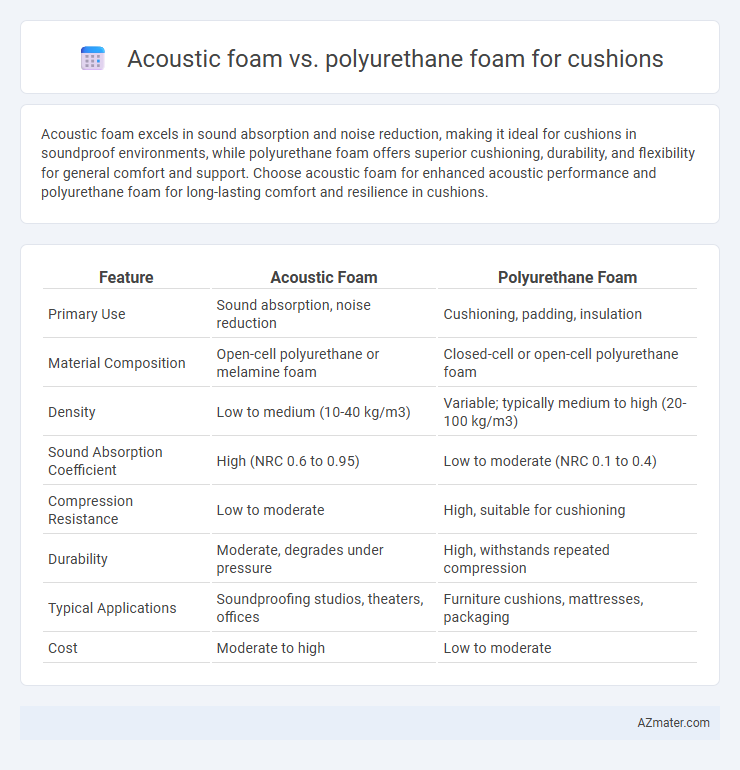Acoustic foam excels in sound absorption and noise reduction, making it ideal for cushions in soundproof environments, while polyurethane foam offers superior cushioning, durability, and flexibility for general comfort and support. Choose acoustic foam for enhanced acoustic performance and polyurethane foam for long-lasting comfort and resilience in cushions.
Table of Comparison
| Feature | Acoustic Foam | Polyurethane Foam |
|---|---|---|
| Primary Use | Sound absorption, noise reduction | Cushioning, padding, insulation |
| Material Composition | Open-cell polyurethane or melamine foam | Closed-cell or open-cell polyurethane foam |
| Density | Low to medium (10-40 kg/m3) | Variable; typically medium to high (20-100 kg/m3) |
| Sound Absorption Coefficient | High (NRC 0.6 to 0.95) | Low to moderate (NRC 0.1 to 0.4) |
| Compression Resistance | Low to moderate | High, suitable for cushioning |
| Durability | Moderate, degrades under pressure | High, withstands repeated compression |
| Typical Applications | Soundproofing studios, theaters, offices | Furniture cushions, mattresses, packaging |
| Cost | Moderate to high | Low to moderate |
Introduction to Foam Cushion Materials
Acoustic foam and polyurethane foam are widely used materials for cushion applications, each offering distinct properties suited to specific needs. Acoustic foam is engineered primarily for sound absorption, featuring an open-cell structure that reduces noise and enhances audio quality in environments like studios and theaters. Polyurethane foam, commonly used in furniture and bedding, provides superior comfort and support with its flexible, durable, and lightweight characteristics tailored for cushioning and impact resistance.
What is Acoustic Foam?
Acoustic foam is a specialized material designed to absorb sound waves, reducing echo and noise in various environments. Unlike polyurethane foam used for cushioning, acoustic foam features a unique open-cell structure that traps and dissipates sound energy, enhancing room acoustics and speech clarity. This foam is commonly used in recording studios, home theaters, and offices to improve sound quality by minimizing reverberation.
What is Polyurethane Foam?
Polyurethane foam is a versatile material made from organic polymers that create flexible, lightweight cushioning with excellent durability and resilience. It offers superior shock absorption and support compared to acoustic foam, making it ideal for high-impact cushioning applications such as furniture and automotive seats. Unlike acoustic foam, which primarily dampens sound, polyurethane foam prioritizes comfort and structural support in cushioning products.
Key Material Differences: Acoustic vs Polyurethane Foam
Acoustic foam is designed with open-cell polyurethane material engineered to absorb sound waves and reduce noise by trapping and dissipating air vibrations, primarily used for soundproofing applications. Polyurethane foam used for cushions typically features a closed-cell or denser open-cell structure, prioritizing comfort, support, and durability rather than sound absorption. The key material difference lies in acoustic foam's specialized porous texture optimized to enhance acoustics, while polyurethane foam balances softness and resilience for cushioning purposes.
Comfort and Support Comparison
Acoustic foam offers superior sound absorption but typically provides less comfort and support compared to polyurethane foam, which is denser and more resilient, making it ideal for cushioning applications. Polyurethane foam delivers enhanced pressure distribution and durability, promoting better posture and prolonged comfort in seating or bedding. Acoustic foam's open-cell structure prioritizes vibration dampening over cushioning support, resulting in a softer, less supportive feel under prolonged use.
Durability and Longevity
Acoustic foam, typically made from open-cell polyurethane, offers excellent sound absorption but may degrade faster under constant compression compared to high-density polyurethane foam used in cushions. Polyurethane foam designed for cushioning boasts superior durability and longevity due to its resilience against wear, tear, and deformation over extended periods. When selecting foam for cushions, high-density polyurethane foam is preferred for its ability to maintain shape and comfort longer than standard acoustic foam.
Breathability and Moisture Resistance
Acoustic foam excels in breathability due to its open-cell structure, allowing air to circulate freely and reducing heat buildup in cushions. Polyurethane foam typically has a denser composition, which limits airflow but offers better moisture resistance by preventing water absorption and promoting faster drying. When selecting cushion materials, prioritizing acoustic foam enhances ventilation and comfort, while polyurethane foam provides superior protection against moisture and mold growth.
Cost and Value Analysis
Acoustic foam typically costs more per cubic foot than polyurethane foam due to its specialized sound-absorbing properties and fire-retardant additives, making it a preferred choice for noise control applications. Polyurethane foam offers a lower upfront cost and versatile cushioning performance but lacks the high-density structure needed for effective soundproofing, limiting its value in acoustic environments. For cushions prioritizing both comfort and sound absorption, acoustic foam presents better long-term value despite the higher initial investment, while polyurethane foam remains economical for general cushioning purposes without noise reduction requirements.
Ideal Applications for Each Foam Type
Acoustic foam excels in sound absorption and noise reduction, making it ideal for recording studios, home theaters, and office soundproofing where controlling reverberation is critical. Polyurethane foam offers superior cushioning, durability, and flexibility, making it perfect for furniture padding, mattress toppers, and automotive seats that require comfort and resilience. Selecting acoustic foam or polyurethane foam depends on whether the primary need is sound control or cushioning support.
Choosing the Right Foam for Your Cushion Needs
Acoustic foam and polyurethane foam serve different purposes when selecting cushions: acoustic foam excels in sound absorption due to its open-cell structure, making it ideal for noise reduction environments, while polyurethane foam offers superior comfort and support with its dense, flexible composition. For cushions prioritizing ergonomic support and durability, polyurethane foam is preferred, whereas acoustic foam suits applications requiring noise dampening alongside moderate cushioning. Consider factors like firmness, durability, and sound insulation properties to choose the optimal foam tailored to your specific cushion requirements.

Infographic: Acoustic foam vs Polyurethane foam for Cushion
 azmater.com
azmater.com